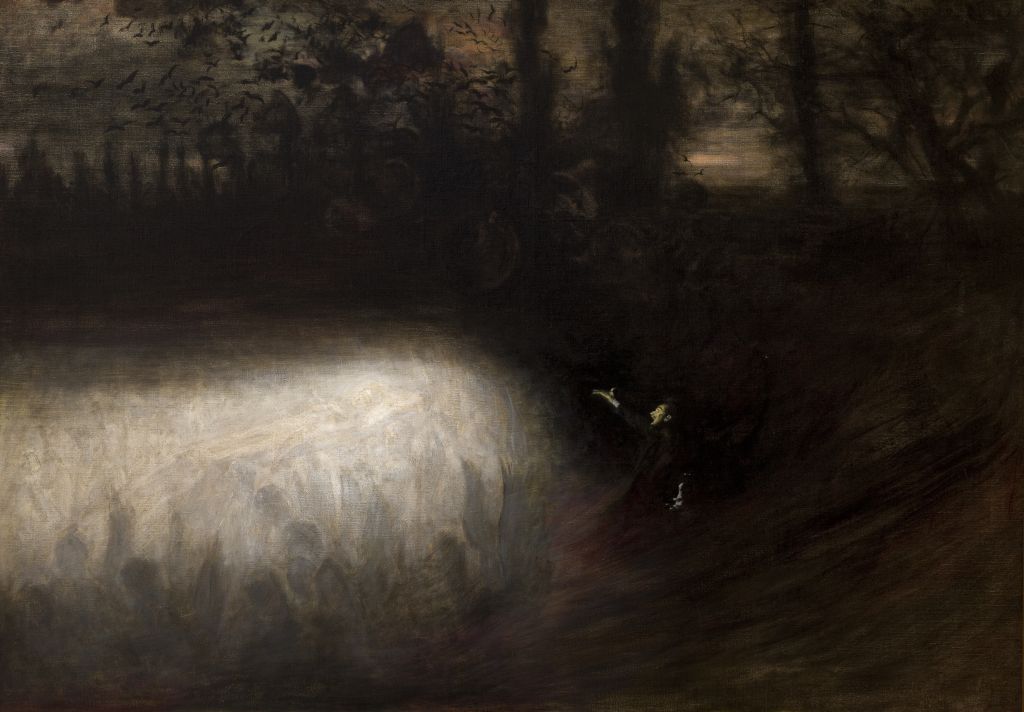This sudden turning point was marked by public display of Taniec szkieletow (The Dance of Skeletons) in 1892. It shows a procession of naked women whirling with skeletons in an abstract space. Podkowiński drew on one of the topos of symbolic iconography – the inevitability of the passing of time and life. Similarly literary in its symbolic aspect and fragile narration are Miraże –kompozycja symboliczna,1893, (Mirages – Symbolic Composition), Ironia. Fantazja. Oddaj mi serce,1893, ( Irony. Fantasy. Give Me That Heart Back); and Nocturn – bajka o zaklętej królewnie,1893, (Nocturne – a Fairytale About a Charmed Princess).
Władysław Podkowiński, Frenzy of Exultations, oil on canvas, courtesy of National Museum, KrakówHis best known painting, Szał uniesień (Frenzy of Exultations), first exhibited in Zacheta Gallery in 1894, with its daring depiction of the well known iconographic motif of a naked woman on a horse, was surrounded by an atmosphere of scandal and public outcry, which escalated further after Podkowiński's attempt to destroy his own canvas. However, in some circles of critics and artist the painting has been considered as a manifesto of new art and a sign of rebellion challenging established aesthetical canons. Driven by instinctive erotic forces, the woman on a demonic steed embodied destructive power.
One of the examples of an antithesis to monumental, representative portraits of women painted against the background of decorative curtains - Portret, 1891, (Portrait of Stanisława Maszyńska); Portret, 1891, ( Portrait of Ewa Kotarbińska); Portret,1893, (Portrait of Teresa Jasieńska) - was the painting Rozmowa (Conversation), completed in 1894. It depicts two women confiding a secret in a suspended timeless moment which creates a specific emotional tension. The dynamic of the paintbrush and the predominant tone of red saturating the fabric of models' dresses as well as the abstract background, give the painting a predatory expression, and deepen its peculiar and painful aura.
 Władysław Podkowiński, Chopin's Funeral March,1894, oil on canvas, photo: courtesy of National Museum, Kraków
Władysław Podkowiński, Chopin's Funeral March,1894, oil on canvas, photo: courtesy of National Museum, KrakówThe painting that entirely belongs to the thematic area of Symbolism is Podkowiński's last, unfinished composition Marsz żałobny Chopina,1894, (Chopin's Funeral March). The painting, inspired by the poem of Kornel Ujejski Marsz Pogrzebowy (Funeral March), (from the series Tłumaczenia Chopina i Beethovena, 1857 – 1860), responds to the major demand of Symbolism – the call for synesthesia, that is, simultaneous perception of visual, musical and poetic sensations. The amorphic patch of white, in which dissolves, just like in fog, the funeral procession carrying the body of a loved one, was contrasted with the darkness, into which a man plunges in despair, surrounded by an ominous landscape. The expression of suffering has been condensed into the dramatic gesture and the grimacing face of the abandoned man.
Podkowiński exhibited his works in Zachęta Gallery (1890-1894), in the Salon of Aleksander Krywult (1891,1893), and in the Society of Friends of Fine Arts in Kraków (1891, 1893). He also participated in international exhibitions in Munich (1892), Chicago (1893), San Francisco and Los Angeles (1894).
Originally written in Polish by Irena Kossowska, Polish Academy of Sciences, September 2002, translated into English by GS. May 2014